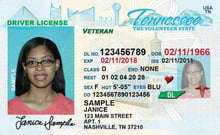

All your missed questions are saved
automatically for extra practice.




It's a practice test that's automatically made up of all your missed questions. Once you finish this test, you’ll be able to revisit your Challenge Bank™ to practice and sharpen your skills.
View All PlansAdding difficult questions to Challenge Bank™ is an exclusive Premium feature. Unlock access to 650+ exam-like questions, a Pass Guarantee, personalized study plans, and more.
View All PlansFree Tennessee DMV Driving Practice Test 2026
| 90-100 | => | 10% |
| 80-89 | => | 13% |
| 70-79 | => | 20% |
| 60-69 | => | 23% |
| <60% | => | 33% |
Our free online Tennessee DMV permit practice test, updated for January 2026, is your best resource to prepare for the knowledge (learner’s) permit test issued by the DMV. This free driver’s license practice test features questions and answers derived from the Tennessee DMV 2026 Driver Handbook. Our practice tests provide instant feedback so that if you miss a question, you’ll know right away why a different response is better. Additionally, our tests mimic what you will face on the official Tennessee written test. The Tennessee learner’s permit test consists of 30 multiple-choice questions comprising four sections: road signs and signals, road rules, drugs and alcohol, and safe driving practices. To pass, applicants must answer at least 24 questions correctly (80%). In Tennessee, there are also online options for taking the knowledge test. This is something you might look into further with your local DMV.


Reviewed for legal and handbook accuracy
M.S., Chief Educational Researcher (ACES member)
Last verified for accuracy on
How to use this practice test
- Start here. One of 4 free Tennessee tests. ~6 min. Read explanations as you go.
- Cover more ground. All tests have different questions - no repeats.
- Finish strong. Try the Exam Simulator for a full-length run.
Why this works
- Exam-like questions from the current handbook + questions most people get wrong. Explanations cite the manual.
- AI Assistant explains like a friend.
- Performance Insights shows where you need work.
- Challenge Bank™ saves your mistakes for targeted practice.
- Proven Progress Students improve from 65% → 72% after just 3 tests.
Actual DMV permit test: What to expect?
- Where: Any Tennessee DMV office (find locations)
- Bring: ID + SSN + residency proof + permit/license fee (see checklist)
- If you fail: Retake the next day.
- Top reasons for failure: legal blood alcohol limits and DUI rules, lane changes and blind spots.
- Ready to schedule? Book your TN DMV appointment
Real Tennessee drivers who passed first try
Verified student reviews • Shared with permission
About the Tennessee learner permit
Tennessee has implemented a graduated driver’s license (GDL) program for applicants under 18 that introduces additional benefits (and responsibilities) incrementally instead of the full license at once. To obtain a learner’s permit in Tennessee, you must first pass the vision screening and written permit test, so this preparation really marks the beginning of your process to become a fully licensed driver.
In Tennessee, the GDL program has three steps: the learner’s permit, during which your driving must be supervised; the Intermediate Restricted License, during which your driving is restricted to daylight with restrictions on carrying passengers; and the Intermediate Unrestricted License. Your participation in the GDL program ends and you obtain a regular driver’s license once you turn 18 or have held the intermediate restricted license for 12 months and turned 17.
When you have studied, practiced with our online practice tests, and feel prepared, just go to the Tennessee DMV with your identification documents and two proofs of residency (if you’re under 18, the proofs should have the name of your parent/guardian). You’ll also need your social security number and an SF1010 form proving school attendance and progress if you’re under 18. Be sure to check with your local DMV for any additional requirements. Once you’ve arrived, you’ll submit the documents, pay the fee, and take the knowledge test. Check out our other free Tennessee DMV permit practice tests as well.
More TN DMV written exam resources
Are you in another state?
- Alabama
- Alaska
- Arizona
- Arkansas
- California
- Colorado
- Connecticut
- Delaware
- District of Columbia
- Florida
- Georgia
- Hawaii
- Idaho
- Illinois
- Indiana
- Iowa
- Kansas
- Kentucky
- Louisiana
- Maine
- Maryland
- Massachusetts
- Michigan
- Minnesota
- Mississippi
- Missouri
- Montana
- Nebraska
- Nevada
- New Hampshire
- New Jersey
- New Mexico
- New York
- North Carolina
- North Dakota
- Ohio
- Oklahoma
- Oregon
- Pennsylvania
- Rhode Island
- South Carolina
- South Dakota
- Tennessee
- Texas
- Utah
- Vermont
- Virginia
- Washington
- West Virginia
- Wisconsin
- Wyoming
We know what it takes to pass. And we’ve got the proof.
Driver’s Ed is - nobody wants to set foot inside the DMV. That’s why millions of learners trust us for simple, visual, effective prep.
An official & trusted partner in driver education
We are an officially recognized FMCSA Entry-Level Driver Training provider and a proud partner to over 2,500 libraries. We work with safety organizations like GHSA and the National Safety Council to help create safer roads for everyone.






A smarter way to study
Challenge Bank™
Our trademarked system automatically saves questions you miss, creating personalized tests that target your weak spots until you’ve mastered the material.
AI-powered feedback
Get smarter as you study. Our new AI-powered feedback provides detailed, question-level insights to help you understand the why behind each answer.
Interactive handbook
Go beyond the boring black-and-white manual. Our interactive handbook lets you read, listen with an MP3 audio version, or even chat with it to find the information you need, faster.
We build our practice questions from the current 2026 TN Driver Handbook and refine them using patterns recent test‑takers report.
Driver handbook • Knowledge‑test/permit overview • Fees & ID requirements • Office/appointment info
We mirror recurring themes (e.g., right‑of‑way traps, sign look‑alikes) and use similar distractors and wording styles.
We don’t collect or publish actual test items and we’re not affiliated with DMV.

